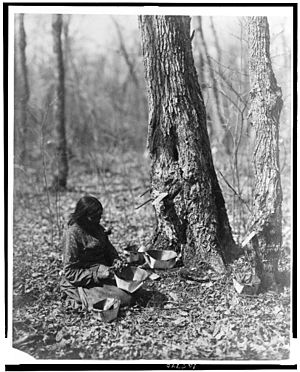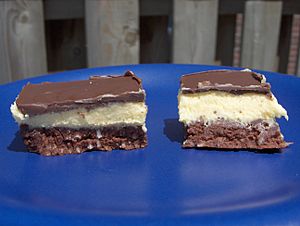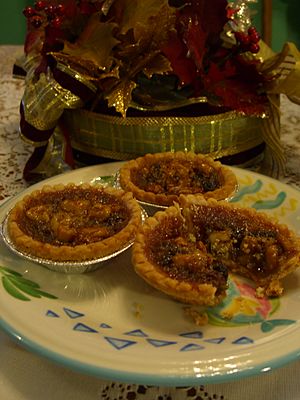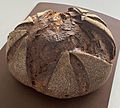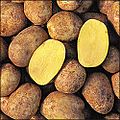Canadian cuisine facts for kids
Canadian cuisine is a mix of many different foods from all over the world! It changes a lot depending on where you are in Canada. The first types of food in Canada came from the Indigenous peoples, and also from English, Scottish, and French settlers.
Traditional food in English Canada is quite similar to British food. The traditional food in French Canada grew from 16th-century French cuisine and the tough life the early settlers in New France had. French Canadian food is now often split into Québécois food and Acadian cuisine.
Later, many people moved to Canada from Central, Southern, and Eastern Europe, South Asia, East Asia, and the Caribbean. They brought their own delicious foods, which added even more variety to Canadian cooking!
Contents
What Makes Canadian Food Unique?
It can be tricky to say exactly what "Canadian food" is, because it's such a big country with so many different cultures. Some people, like former Prime Minister Joe Clark, thought Canadian food was like a "smorgasbord" – a big table with lots of different dishes from many cultures.
Even though it's diverse, there are some things that make Canadian food special. Food expert Lenore Newman says Canadian food is unique because it uses:
- Seasonal foods: Eating what's fresh and available each season.
- Multiculturalism: A mix of many different cultures.
- Wild foods: Using ingredients found in nature.
- Regional dishes: Special foods found only in certain parts of Canada.
- Ingredients over recipes: Focusing on great ingredients more than complicated recipes.
Indigenous foods are a very important part of Canadian cuisine. Foods like bannock (a type of fried bread), moose, deer, bison, pemmican (dried meat and fat), and maple taffy are traditional Indigenous foods. They are eaten all across the country.
Other foods that started in Canada include peameal bacon and Nanaimo bars. Some foods that didn't start in Canada are also very popular, like pierogies (dumplings from Central and Eastern Europe), because many Ukrainian and Polish immigrants came to Canada.
Some foods are more popular in certain areas. For example, dulse (a type of seaweed) is popular in the Maritimes, and poutine is very popular in French-speaking parts of Canada, especially Quebec. Generally, Canadian foods often include lots of starchy foods, breads, game meats (like deer or moose), and many stews and soups.
How Different Cultures Shaped Canadian Food
Canadian food has been shaped by Indigenous peoples, early European settlers, and later immigrants.
Indigenous Peoples' Contributions
Traditional Indigenous food in Canada used a mix of wild game, foraged plants, and farmed crops. Each First Nations and Inuit group used the foods found in their area and their own cooking methods.
Maple syrup was first gathered and used by Indigenous peoples in Eastern Canada and the Northeastern US. Canada is now the world's biggest producer of maple syrup! It's one of the most common Canadian foods with Indigenous roots.
Dried meat products like pânsâwân and pemmican were often eaten by Indigenous peoples of the plains. Pânsâwân was an early version of North American beef jerky.
On the West Coast, Pacific salmon was a very important food for First Nations. Salmon was eaten fresh or smoked and dried to make a jerky-like food that could be stored all year. This is now known as "salmon jerky."
Whipped soapberry, called sxusem (sk-HOO-shum) in British Columbia, is eaten like ice cream. In the Arctic, a similar dish with animal fat is called agutak.
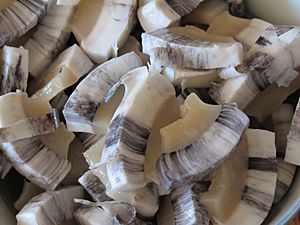
In the Arctic, Inuit people traditionally ate land and sea mammals, fish, and plants. Meats were eaten fresh or fermented into foods like igunaq or kiviak. Snacks like muktuk (whale skin and blubber) are eaten plain or dipped in soy sauce.
Fish is eaten boiled or fried. Plants like the "Eskimo potato" (oak-kuk) were also eaten.
Foods like "bannock" became popular with First Nations and Inuit after they traded with French fur traders. These traders brought new ingredients. Today, some Indigenous Canadians still eat bannock, powdered milk, and bologna. This shows how their food traditions changed after European settlement.
European Settlers and Immigrants
Early English Canada, especially in the Maritimes and Southern Ontario, was influenced by settlers from the British Isles. Southwestern Ontario also has strong Dutch and Scandinavian influences.
French settlers, who became the Canadiens and Acadians, shaped the food of southern Quebec, Northeastern Ontario, and New Brunswick.
In Canada's Prairie provinces, many immigrants from Eastern and Northern Europe arrived before World War I. This led to strong Ukrainian, German, and Polish cuisine influences. The food of the Doukhobors, who are Russian vegetarians, is also important in some areas of British Columbia and the Prairies.
The Waterloo, Ontario, area and southern Manitoba have strong Mennonite and Germanic cooking traditions.
The food of Newfoundland and the Maritime provinces mostly comes from British and Irish cooking. They often prefer salt-cured fish, beef, and pork. Ontario, Manitoba, and British Columbia also have strong British food traditions.
Jewish immigrants in the late 1800s brought important foods to Canada, especially Montreal-style bagels and Montreal-style smoked meat. In Winnipeg, Manitoba, the Jewish community created their own versions of these, plus unique dishes like the schmoo torte and smoked goldeye.
Asian Immigrants
Many "Chinese dishes" in Canada are actually Canadian or North American creations. Chinese restaurants often changed their traditional cuisine to fit local tastes. This "Canadian Chinese cuisine" is found everywhere, with different dishes in different cities. For example, Calgary has ginger beef, and Montreal has peanut-butter dumplings.
The Chinese buffet started in Gastown, Vancouver, around 1870. It came from the practice of Chinese cooks setting out a steam table for Scandinavian workers in the area.
Unique Indo-Canadian food includes East Indian roti, which became popular in Toronto in the 1980s and 1990s. It uses North Indian/Pakistani bread and curries as stuffing. This dish was inspired by West Indian roti, which came to the city earlier. Also known as butter chicken roti, it's served in many Indian restaurants in Southern Ontario.
Indian food is very popular in Canada, mostly from Northern Indian cuisine. It uses bread, curry, and often yogurt and cream in meat dishes. It also gets ideas from South Indian food, using sour and spicy flavors.
From Southeast Asia, a special medium-thick crust pizza Margherita in Toronto is an example of fusion cuisine. It has a garlic and basil oil topping, mixing Italian pizza with the Vietnamese tradition of using herbed oil.
Canada's National Foods
Foods often thought of as Canada's national dishes include poutine and butter tarts.
An informal survey by The Globe and Mail newspaper asked people what they thought was the Canadian national dish. Here's what they said:
- Poutine (51%)
- Montreal-style bagels (14%)
- Salmon jerky (dried smoked salmon) (11%)
- Perogy/Pierogi (10%)
- Ketchup chips (7%)
- Nova Scotian donair (4%)
- California roll (1%)
In 2012, the Canadian Broadcasting Corporation asked Canadians about their most "iconic" foods. The top choices were:
Regional Specialties
Even though many ingredients are found across Canada, each region has its own history and local people, leading to unique ingredients and dishes.
| Ingredient | Defining dish | Pacific | Mountain | The Prairies | Ontario | Quebec | Atlantic | Northern |
|---|---|---|---|---|---|---|---|---|
| Caribou | Caribou stew | X | X | X | ||||
| Potatoes | Poutine | X | X | X | ||||
| Saskatoon berries | Saskatoon berry jam, Saskatoon berry pie | X | X | X | ||||
| Fiddlehead ferns | Boiled fiddleheads | X | X | X | ||||
| Cloudberry | Bakeapple pie | X | X | |||||
| Maple syrup | Pancake topping | X | X | X | ||||
| Dulse | Dulse crisps | X | ||||||
| Harp seal | Flipper pie | X | X | |||||
| Sockeye | Smoked salmon | X | ||||||
| Pacific salmon | Cedar-plank salmon | X | ||||||
| Atlantic salmon | Smoked salmon | X | X | |||||
| Atlantic cod | Fish and brewis | X | X | |||||
| Lobster | Boiled lobster | X | X | |||||
| Winnipeg goldeye | Smoked goldeye | X | ||||||
| Pork | Farmer sausage | X | ||||||
| Summer savoury | Dressing | X |
Many Canadians still hunt and eat wild game, though less so in cities. Venison (from deer, moose, or caribou) is eaten across the country and is very important to many First Nations cultures. Seal meat is eaten in the Canadian North, the Maritimes, and Newfoundland. Wild birds like ducks, geese, and grouse are also hunted. Some people also eat bear and beaver, especially hunters or Indigenous people.
West Coast salmon types include sockeye, coho, Chinook, and pink salmon. Freshwater fish like walleye and lake whitefish are popular in southern Ontario. Both wild and farmed rainbow trout are eaten across Canada.
Wild mushrooms like chanterelle, pine, and morel are commonly eaten. Canada also makes good cheeses and many successful beers. It's famous for its excellent ice wines and ice ciders. Berries like gooseberries, cranberries, and strawberries are gathered wild or grown.
Popular Canadian Foods
Here are some of the most well-known Canadian foods.
Savoury Dishes
While Canadian food shares some similarities with other North American cuisines, many unique dishes are found only in Canada. Some are more commonly eaten than others.
| Dish | Description | Pacific | Mountain | The Prairies | Ontario | Quebec | Atlantic | Northern |
|---|---|---|---|---|---|---|---|---|
| Calgary-style ginger beef | Crispy deep-fried beef with a sweet ginger sauce. | X | O | X | ||||
| Roast beef with Yorkshire pudding | A traditional Sunday dinner for Canadians with British roots. | X | X | X | X | X | X | |
| Roast turkey | A common North American roast turkey meal. | X | X | X | X | X | X | |
| Baked beans | Beans cooked with maple syrup. | X | X | X | X | X | X | |
| B.C. roll | A type of sushi with salmon. | O | X | X | ||||
| California roll | A popular type of sushi. | O | X | X | X | |||
| Dynamite roll | A type of sushi usually with prawn tempura. | O | X | X | X | |||
| Sushi pizza | A fusion dish with a fried rice patty base and sushi toppings. | X | X | X | O | X | X | |
| Jiggs dinner | A Sunday meal similar to a New England boiled dinner. | O | ||||||
| Back or peameal bacon | Bacon that includes the pork loin from the back of the pig. | X | X | X | O | X | ||
| Tourtière | A meat pie made of pork and lard. | X | X | X | X | O | X | |
| Montreal-style smoked meat | Deli-style cured beef. | X | X | X | O | X | ||
| Bannock | A fried bread or dough food. | X | X | X | X | X | X | |
| Bouilli | Québécois beef and vegetable pot roast. | O | ||||||
| Bologna stew | A stew made with cubed Bologna sausage. | O | ||||||
| Yellow pea soup | Split pea soup eaten by early settlers. | X | X | O | X | |||
| Poutine | French fries topped with cheese curds and gravy. | X | X | X | X | O | X | X |
| Montreal-style bagels | A sweet, firm, wood-fired bagel. | X | O | |||||
| Pemmican | Ground dried meat, fat, and berries. | X | X | |||||
| Oka cheese | Cheese originally made by monks. | X | X | O | ||||
| Flipper pie | Pie made with harp seal flipper. | O | ||||||
| Hot chicken sandwich | Chicken (or turkey) sandwich covered in gravy and peas. | X | X | X | X | X | ||
| Toutons | Fried bread from Newfoundland. | O | ||||||
| Fish and brewis | Salt cod and hardtack, with pork cracklings. | O | ||||||
| Rappie pie | A casserole made of grated potato and meat. | O | ||||||
| Cretons | A pork spread with onions and spices. | X | O | |||||
| Poutine râpée | Grated Acadian stuffed potato dumpling. | O | ||||||
| Nova Scotian donair | Ground beef doner kebab with a sweet milk sauce. | X | X | X | O | |||
| Garlic fingers | Dough with cheese, garlic, and sometimes meat, similar to pizza. | X | X | X | X | O | ||
| Lobster roll | Lobster meat mixed with mayonnaise, served in a toasted hot dog bun. | X | X | O | ||||
| Cipaille/sea-pie | Fish and meat layered in a pie. | X | O | X | ||||
| Pictou County pizza | A regional pizza from Nova Scotia with a unique sauce. | O |
Sweet Treats
- Beaver tails—also known as elephant ears or moose antlers, these are simply fried dough.
- Bumbleberry pie—a pie made from a mix of fruits, berries, and rhubarb.
- Butter tarts—said to have been invented in Eastern Ontario around 1915. They have a filling of butter, sugar, and eggs, often with raisins or pecans.
- Candy apple—apples covered in a hard candy coating.
- Cinnamon buns—sweet rolls with cinnamon.
- Date squares—desserts filled with dates.
- Figgy duff—a pudding from Newfoundland.
- Jam busters—jelly doughnuts from the Prairies.
- Flapper pie—a custard pie popular in Western Canada.
- Grandpères—dough dumplings boiled in maple syrup.
- Maple syrup—used as a topping for pancakes or in treats like tire d'érable sur la neige (maple taffy on snow).
- Maple taffy—a candy made by pouring hot maple sap onto snow.
- Moosehunters—molasses cookies.
- Nanaimo bars—most common in British Columbia.
- Nougabricot—a Québécois preserve with apricots, almonds, and pistachios.
- Persians—a mix between a cinnamon bun and a doughnut, topped with strawberry icing. Unique to Thunder Bay, Ontario.
- Pets de sœurs—"nuns’ farts," pastry dough wrapped around a brown sugar and butter filling.
- Pouding chômeur—"poor man’s pudding," a simple, sweet dessert.
- Saskatoonberry pie—pie made from saskatoonberries.
- Sucre à la crème—Québécois sweet milk squares.
- Sugar pie—"tarte au sucre," a Québécois pie based on a French dessert.
Commercially Prepared Foods and Drinks
- Canadian pizza—usually has tomato sauce, mozzarella cheese, bacon, pepperoni, and mushrooms. In Quebec, it's often called pizza québécoise.
- Candy
- Bridge mixture
- Chocolate bars: Coffee Crisp, Mr. Big, Caramilk, Big Turk, Cherry Blossom, Crunchie, Crispy Crunch, Aero, Pal-o-mine, Eat-more Chocolate bar, Canadian Smarties.
- Glosette pieces (peanut, raisin, or almonds)
- Baby food
- Cereal
- Red River Cereal
- Shreddies
- Vector
- Coffee—Canada is one of the top coffee-drinking countries in the world!
- Nabob Coffee
- Second Cup Coffee
- Tim Hortons
- Cows ice cream
- Honey dill sauce
- Kraft Dinner (macaroni and cheese)
- Non-alcoholic drinks
- Bagged milk
- Brio chinotto
- Canada Dry ginger ale
- London Fog
- Red Rose Tea
- Spruce beer—bière d'épinette, a non-alcoholic soft drink from Quebec.
- Snacks
- Ketchup, salt and vinegar, dill pickle, and "all dressed" flavoured potato chips
- Hawkins Cheezies
- Hostess Potato Chips
- Ringolos and Humpty Dumpty Party Mix
- Nuts and Bolts (like Chex Mix)
- Tiger tail ice cream—black licorice and orange-flavored ice cream, once popular across Canada.
Street Food
Many Canadian cities offer a variety of street food. While poutine is available almost everywhere, it's much more common in Quebec.
Similarly, sausage stands are found across Canada, but are very common in Ontario. They are often sold from mobile food trucks called "fry trucks" or "chip trucks."
In Western Canada, a type of Ukrainian garlic-pork sausage called "Kubasa" is very popular. "Smokies" might refer to Kubasa rather than hot dogs.
New fusion foods are always appearing, like the Japadog. This is a hot dog topped with Japanese ingredients like wasabi, teriyaki, or shredded daikon radish.
Each Canadian region has its own street food specialties that show its cultural influences. Montreal food trucks offer shish taouk, the Montreal hot dog, and dollar falafels. In Vancouver, you'll find lots of Asian-influenced foods like sushi, samosas, Vietnamese banh mi subs or Pho soup, and Filipino dishes. In Victoria, British Columbia, you can find vegan burgers, seafood, and Mexican street food.
Pizza slices are a common street food. Shawarma is very popular in Ottawa and Windsor. Halifax has its own unique version of the döner kebab called the donair, which has a special sweet sauce made from condensed milk, sugar, garlic, and vinegar.
Ice cream trucks are seen (and heard!) across the country during summer. Winnipeg has many famous food trucks on Main Street. Since 2007, Toronto has encouraged vendors to sell street food from a wider range of cuisines.
Meal Formats
- Chinese smorgasbord: A buffet-style meal with Chinese dishes.
- Lumberjack's breakfast: Also called a logger's breakfast or "The Lumby." This is a huge breakfast with three or more eggs, ham, bacon, sausages, and several large pancakes. It was invented around 1870 in Vancouver for workers who needed a big meal before a long day.
Images for kids
-
Canadian pancake breakfast in Calgary
-
Oatcakes were first brought to Atlantic Canada by Scottish Highlanders in 1773. They are still a popular snack in Halifax coffee shops.
-
Wild turkeys in Ottawa
-
Canadians having tea at a picnic beside the Bay of Quinte, Prince Edward County (1909 August)
-
Loaf of Ukrainian rye bread from New Westminster
-
Sai Woo restaurant and heritage building in Vancouver Chinatown
-
Kedgeree, an Anglo-Indian dish from the British Raj, is often found in Indo-Canadian restaurants.
-
Oka cheese was first made in monasteries in Oka, Quebec and Holland, Manitoba.
-
The annual pancake breakfast at the Chinook Centre in Calgary feeds over 60,000 people in one day.
-
The "Aurora Golden Gala" apple was created in Summerland, British Columbia.
-
The "Yukon Gold" potato was developed at the University of Guelph.
-
Tourtière from Granville Island Public Market.
See also
 In Spanish: Gastronomía de Canadá para niños
In Spanish: Gastronomía de Canadá para niños


